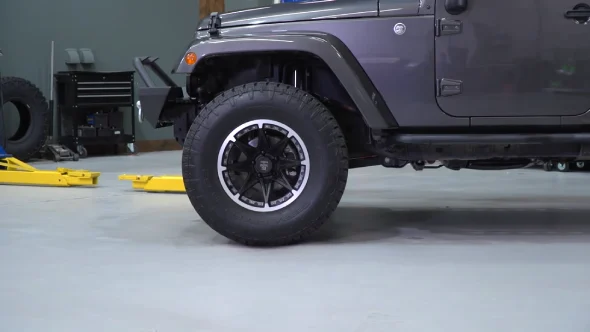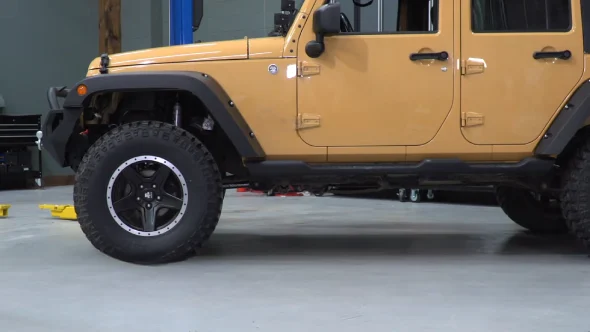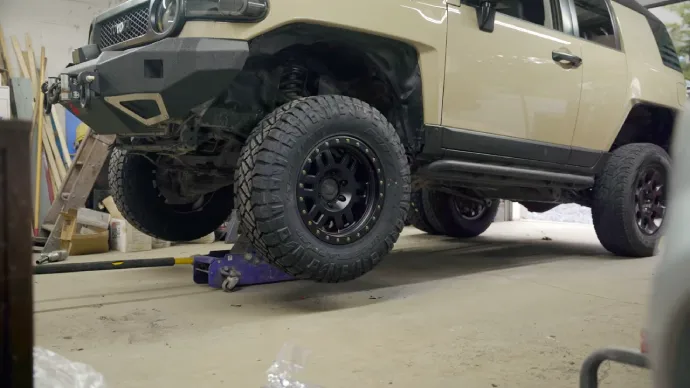Last Updated on April 15, 2023
Are you looking to improve your 33-inch tire vehicle’s look, performance, and capability? If so, installing a lift kit is worth considering. Not only does it provide you with increased ground clearance and traction, but it also gives your off-road vehicle an added stylish look.
With this in mind, one of the most appealing benefits of installing a lift kit is that it improves your vehicle’s overall handling and performance. A lift kit can be beneficial when navigating tight turns or rough terrain. The aesthetic appeal of larger tires can make your car stand out from the crowd.
Our expertly crafted guide will walk you through every step of the installation process, providing all the knowledge necessary to get on the road in no time.
Why Do You Need A Lift Kit For 33 Inch Tires: Reasons

A tire lift kit can provide a range of benefits for off-road enthusiasts or those who need more ground clearance for their vehicles. You might want to think about installing a 33-inch lift kit on your car if you are considering the following reasons:
01. Improved Clearance From UCA
33-inch tire lift kits provide improved clearance from the upper control arms (UCA). The lift kit increases the distance between the frame mounts and suspension components, allowing for greater suspension travel and better articulation.
Not only does this provide more clearance when off-roading, but it also helps reduce wear on suspension parts and eliminates any rubbing issues with larger tires. Increased clearance allows for an improved approach angle for tackling challenging terrain.
02. Increased Ground Clearance And Traction
33-inch tire lift kits installed can drastically increase ground clearance and traction in off-road conditions. With more ground clearance, there is less risk of getting hung up on rocks or logs while navigating trail obstacles, leading to fewer wheel/tire damages.
Riding smoother on uneven surfaces with larger tires is easier since they can absorb bumps and dips in the terrain while maintaining vehicle stability. The increased surface area allows for a higher grip on sand or mud and greater dispersal of power across a larger area than smaller tires allow.
03. More Stylish Look And Better Off-Road Performance
One of the most appealing aspects of installing 33-inch tire lift kits is its aesthetic appeal. Increasing your vehicle’s ride height gives your car a much sportier look that makes it stand out compared to other vehicles on the road or trails you might be exploring.
Increasing tire size improves stability when taking turns or driving on bumpy roads. Bigger tires have improved contact with the ground compared to smaller tires. This ultimately leads to a better offroad performance by providing greater traction and maneuverability through tough terrain.
04. Avoidance Scrubbing At Full Lock Or Complete Turn In Reverse
The 33-inch tire lift kit reduces scrubbing at maximum turning and in reverse. Raised suspension components elevate tires away from contact with fenders and body panels while turning sharply at slow speeds.
It is possible to prevent premature damage to wheels and suspension parts. Reduces stress on these components, avoiding unexpected issues during the journey.
Larger wheel sizes provide increased traction and grip compared to smaller wheels. This allows for safer navigation, even when traversing rough terrain or making sharp turns.
05. Enhanced Off-Road Performance And Capability
An off-road tire lift kit grants your vehicle enhanced performance capabilities within offroad scenarios due mainly to its ability to raise ride height.
The 33-inch tire lift kit increases ground clearance, allowing for easier traversing of obstacles. It improved approach angles when tackling inclines. More ground clearance provides for previously impossible movement with a standard suspension setup.
Larger 33-inch tire wheels absorb shocks better than smaller wheels. This improves handling when navigating rough patches on roads and trails.
06 Aesthetic Appeals Of Larger Tires
When installing the tire lift kit, not only do you get enhanced performance when driving offroad, but also an aesthetically pleasing look too.
Large wheel sizes can give a vehicle an impressive appearance. This look can help draw attention without being gaudy. Choosing large wheels provides culture.
Car equipped with large wheel sizes for improved control. It gives the driver confidence to tackle any terrain.
07. Improved Overall Vehicle Handling And Performance
The tire lift kit improves overall vehicle handling performance. Larger wheel sizes allow for higher levels of responsiveness when cornering thanks to their increased inertia meaning quicker acceleration or deceleration times regardless of speed.
33-inch tires provide better contact with ground surfaces. Better ground traction ensures smooth rides on both paved and unpaved surfaces. It gives drivers peace of mind knowing their car performance is reliable in various environments.
A Step-By-Step Guide: How To Install A Lift Kit For 33-Inch Tires

Installing a lift kit is a great way to make room for larger tires on your vehicle. An installation guide for 33-inch lift kits is provided here for you:
Note: This guide is for general informational purposes only. The installation of a lift kit requires mechanical knowledge, and we recommend consulting a professional mechanic for assistance.
Step 1: Gather The Necessary Tools And Materials
Before beginning the installation process, you must gather all the necessary tools and materials for the job.
This includes items such as a 2-inch suspension kit, front-end leveling kit, wheel spacers, jack stands, and any other materials required by your specific lift kit. Ensure you have everything you need before starting work on your vehicle.
Step 2: Considerations Before Installation
Consider factors such as terrain and weight load of the vehicle when designing the lift kit. Gather necessary tools and materials for installation.
Step 3: Removing Existing Shocks And Springs
To install your new lift kit, remove all existing shocks and springs from your car’s suspension system using proper tools such as ratchets or wrenches.
Carefully inspect each component before removing them to identify any potential problems early on to avoid further complications.
Once all components have been removed, clean up any particles left behind from disassembly before proceeding with the installation.
Step 04. Installing New Shocks And Springs
Install your new shocks and springs with accompanying components such as spacer plates or bushings, depending on the lift you choose for your car’s suspension system.
This will allow the larger tires to be supported correctly, allowing them to grip the ground better for improved traction and performance over rough terrain.
The new shocks will also help absorb any bumps or other impacts during off-roading. Ensure that the shocks are aligned correctly and tightened securely before moving on to the next step of installation.
Step 05. Installing Lower Control Arms
These lower control arms connect the wheels and axle assembly to the vehicle’s frame and provide additional stability while driving over obstacles or uneven terrain.
Lower control arms must be fitted correctly to provide adequate support without causing excessive wear on other components or compromising safety. Once fitted properly, the wheels should be securely tightened before taking your vehicle on any trails or off-road adventures.
Step 06. Test Fitment Before Completing The Installation
Fitment testing allows you to check that everything has been installed properly so far, which helps reduce the risk of mistakes being made down the road that could cause problems when out on trails or rough roads later on.
It’s best practice to perform this test fitment before taking your vehicle back out onto public roads, just in case anything needs adjustment or further tightening before continuing with daily use of your vehicle after the installation process has been completed.
Step 07: Securely Tighten All Components Once Fitted
Once everything is checked and fitted together correctly, it’s time to start tightening down all components securely with appropriate tools like wrenches and ratchets until they are snug without being overly tight (which could cause damage).
Ensure that each connection is tightened adequately but not too much, so there isn’t excessive friction when operating the suspension system later.
Step 08: Reattach Tires To Rims And Secure Them In Place With Lug Nuts
Check fitment and securely tighten all components. Reattach tires to rims using lug nuts. Ensure tightness of lug nuts so that no one carries too much weight from one side.
Step 09: Check Tire Pressure
Check tire pressure before proceeding with further testing. Inadequate inflation may cause blowouts, imbalanced tread wear, and resulting in dangerous handling characteristics. Increased stress on tire walls may lead to premature failure over time.
Step 10: Test Out Brakes Lights & Turn Signals
Test brake lights & turn signals for correct function before open road use of the newly installed suspension system. Ensure visibility and awareness when cornering at higher speeds, especially during dusk hours. Improve overall road safety standards before long-distance travel with heavier loads off-road.
Step 11: Take The Vehicle For A Test Drive
Check suspension performance in various terrains. Adjust shocks, struts, spring rates, and dampening levels based on individual preferences. Customize the setup to achieve desired results and provide a maximum comfortable ride.
Does a Lift Kit on 33 Tire-Size Affect the Vehicle’s Tire Pressure?

A lift kit combines parts that raise the vehicle’s body off the frame and allow for larger tires. It’s important to understand how a lift kit affects tire pressure, as it can impact your vehicle’s performance. A lift kit can cause an increase in tire pressure as it increases the distance between your tires and the ground.
The extra space between the wheel and the fender changes the angle at which they meet the ground. The steeper angle puts more stress on the tire, which can cause it to lose air pressure faster than normal.
How Much Weight Can a Lifted Vehicle with 33 Tire-Size Carry?
With increased ground clearance and suspension upgrades, lifted vehicles with 33-inch tires should be able to carry more weight. A lifted vehicle with a 33-inch tire size can typically carry between 500 to 1,500 pounds of additional weight, depending on the factors mentioned above.
Overloading a vehicle can damage the suspension, braking system, and other components, resulting in unsafe driving conditions.
The amount of weight a lifted vehicle can carry depends on several factors. Therefore, we can not provide you with an exact numerical value. These factors include the vehicle’s weight capacity, the suspension and lift kit, and the load’s weight distribution.
It is best to consult with a qualified mechanic or the vehicle manufacturer for specific weight capacity information.
Increasing Performance and Safety: The Vital Importance of Installing a 33-Inch Tire Lift Kit
Installing a lift kit on a Jeep can be an involved process with many factors that affect the total installation cost. There are many lift kits to choose from when making this decision, such as body lifts, suspension lifts, coil spring lifts, shackle lifts, and spacer lifts.
Other factors like the quality of the lift kit and any additional parts needed for the installation play an essential role in the overall cost. These elements should be assessed when deciding how much to invest in a Jeep lift kit.
We hope this information has helped you understand what goes into installing a Jeep lift kit and how it affects the overall cost. Read our other articles for more advice and guidance on Jeep mods and upgrades.

